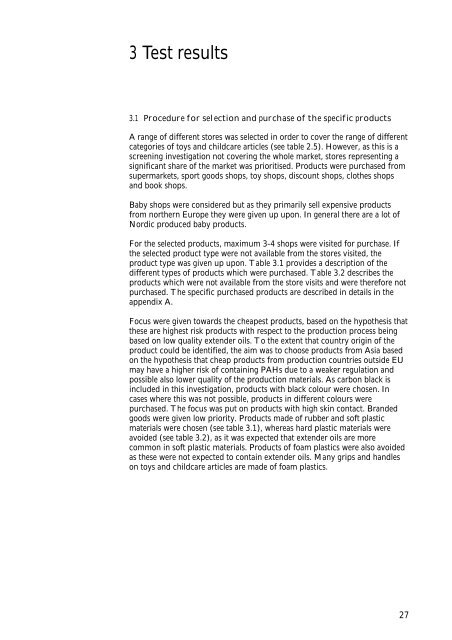PAHs in toys and childcare products - Miljøstyrelsen
PAHs in toys and childcare products - Miljøstyrelsen
PAHs in toys and childcare products - Miljøstyrelsen
You also want an ePaper? Increase the reach of your titles
YUMPU automatically turns print PDFs into web optimized ePapers that Google loves.
3 Test results<br />
3.1 Procedure for selection <strong>and</strong> purchase of the specific <strong>products</strong><br />
A range of different stores was selected <strong>in</strong> order to cover the range of different<br />
categories of <strong>toys</strong> <strong>and</strong> <strong>childcare</strong> articles (see table 2.5). However, as this is a<br />
screen<strong>in</strong>g <strong>in</strong>vestigation not cover<strong>in</strong>g the whole market, stores represent<strong>in</strong>g a<br />
significant share of the market was prioritised. Products were purchased from<br />
supermarkets, sport goods shops, toy shops, discount shops, clothes shops<br />
<strong>and</strong> book shops.<br />
Baby shops were considered but as they primarily sell expensive <strong>products</strong><br />
from northern Europe they were given up upon. In general there are a lot of<br />
Nordic produced baby <strong>products</strong>.<br />
For the selected <strong>products</strong>, maximum 3-4 shops were visited for purchase. If<br />
the selected product type were not available from the stores visited, the<br />
product type was given up upon. Table 3.1 provides a description of the<br />
different types of <strong>products</strong> which were purchased. Table 3.2 describes the<br />
<strong>products</strong> which were not available from the store visits <strong>and</strong> were therefore not<br />
purchased. The specific purchased <strong>products</strong> are described <strong>in</strong> details <strong>in</strong> the<br />
appendix A.<br />
Focus were given towards the cheapest <strong>products</strong>, based on the hypothesis that<br />
these are highest risk <strong>products</strong> with respect to the production process be<strong>in</strong>g<br />
based on low quality extender oils. To the extent that country orig<strong>in</strong> of the<br />
product could be identified, the aim was to choose <strong>products</strong> from Asia based<br />
on the hypothesis that cheap <strong>products</strong> from production countries outside EU<br />
may have a higher risk of conta<strong>in</strong><strong>in</strong>g <strong>PAHs</strong> due to a weaker regulation <strong>and</strong><br />
possible also lower quality of the production materials. As carbon black is<br />
<strong>in</strong>cluded <strong>in</strong> this <strong>in</strong>vestigation, <strong>products</strong> with black colour were chosen. In<br />
cases where this was not possible, <strong>products</strong> <strong>in</strong> different colours were<br />
purchased. The focus was put on <strong>products</strong> with high sk<strong>in</strong> contact. Br<strong>and</strong>ed<br />
goods were given low priority. Products made of rubber <strong>and</strong> soft plastic<br />
materials were chosen (see table 3.1), whereas hard plastic materials were<br />
avoided (see table 3.2), as it was expected that extender oils are more<br />
common <strong>in</strong> soft plastic materials. Products of foam plastics were also avoided<br />
as these were not expected to conta<strong>in</strong> extender oils. Many grips <strong>and</strong> h<strong>and</strong>les<br />
on <strong>toys</strong> <strong>and</strong> <strong>childcare</strong> articles are made of foam plastics.<br />
27

















